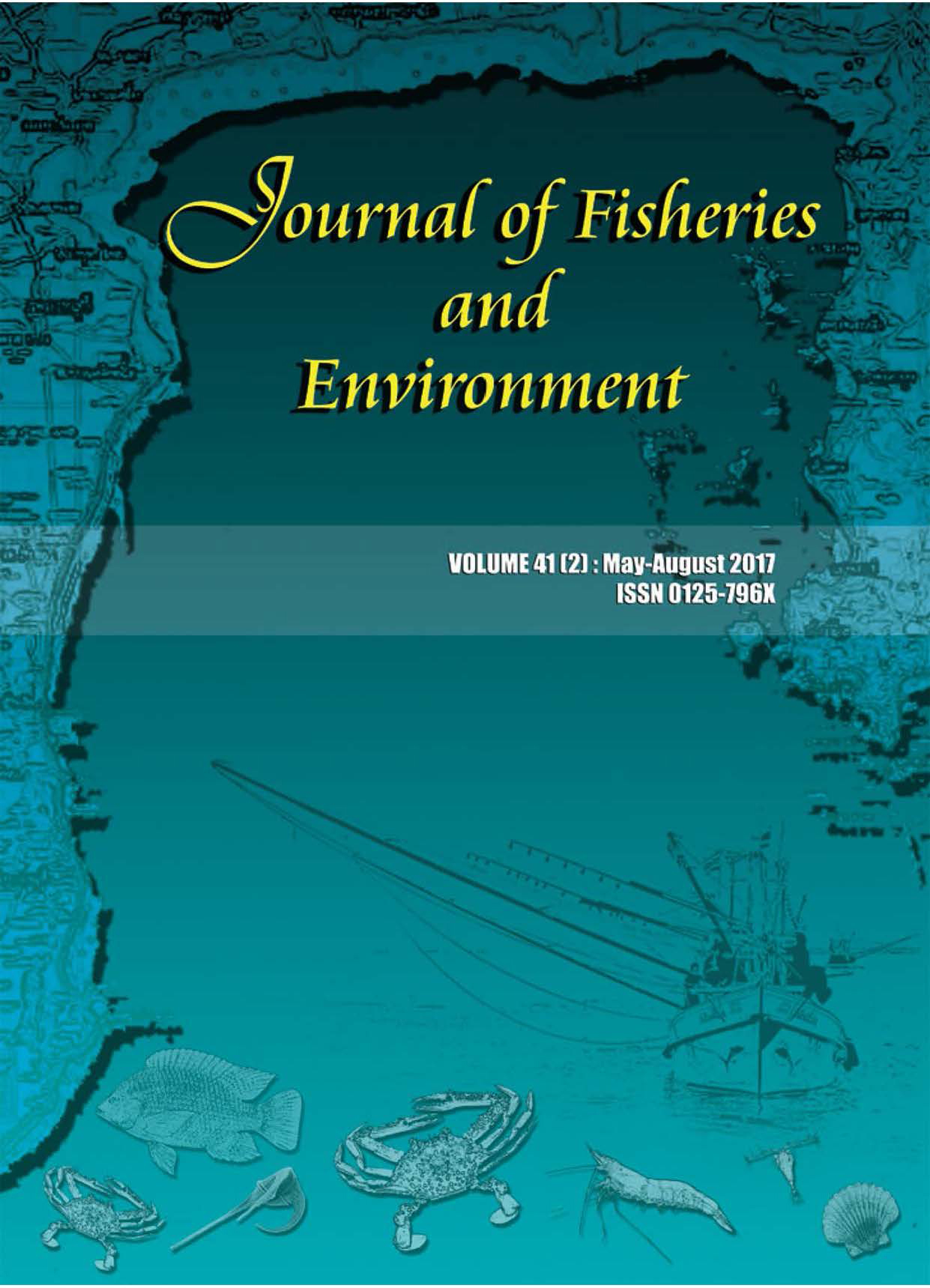Small-scale Squid Large Cast-Net Fisheries during Waxing and Waning Moon Phases in the Klongwan Coastal Area, Prachuap Khiri Khan Province, Thailand
Main Article Content
Abstract
A squid catch study was conducted through onboard surveys using large cast-net fishing at different operations between waxing and waning moon phases in the Klongean coastal area, Prachuap Khiri Khan province in September 2014, January, March and May 2015. The catch and CPUE, including the income obtained, were analyzed. Results showed that the number of caught species from this fishery during the 12th-15th days of a waxing moon was 27 species (4 species of squids, 15 species of marketable value and 8 species of discards) and during the 12th-14th day of a waning moon was 28 species (3 species of squids,17 species of marketable value and 8 species of discards). The average catch rate of target species (Lologinid squids, Loligo spp.) and non-target species, catch composition, CPUE and income from this fishery between waxing and waning moon phases were not significantly different (p>0.05). This study indicated that lunar cycles did not have an impact on squid catch from fishing by large cast-net. Fishing during waxing and waning moon phases produced a rather low daily income, at THB 591.80 and 245.78, respectively. The main daily operating costs were for light generation, at 57.1-71.7% and 53.2-65.5% of total costs, respectively.
Article Details
References
2. Arkronrat, W. and A. Boutson. 2015. Current status of light luring squid (large cast net) fishery in the Klongwan coastal area, Prachuap Khiri Khan province, pp. 1247-1254. In Proceedings of 53rd Kasetsart University Annual Conference. Bangkok, Thailand.
3. Arkronrat, W. and V. Oniam. 2014. Catch per unit of effort and catch composition of squid cast nets by small-scale fishers' Klongwan community, Prachuap Khiri Khan province. Thai Fisheries Gazette 67 (2): 162-167.
4. Arkronrat, W.,V. Oniam and L. Chuchit. 2014. Effect of reduced light powers on catch per unit effort of squid falling net fishing in the Klongwan coastal area, Prachuap Khiri Khan province. Thai Fisheries Gazette 67 (4): 297-304.
5. Bigelow, K.A., C.H. Boggs and X. He. 1999. Environmental effects on swordfish and blue shark catch rates in the US North Pacific longline fishery. Fisheries Oceanography 8: 178-198.
6. Boonsuk, S., A. Kongprom, S. Hoimuk, M. Sumontha and K. Tes-a-sen. 2010. Stock assessment of squids, Photololigo chinensis Gray, 1849 and P. duvaucelii d'Orbigan, 1835 along the Andaman Sea coast of Thailand. Marine Fisheries Research and Development Bureau, Department of Fisheries, Technical paper No. 14/2010.
7. Chiou, W.D., L.Z. Cheng and C.T. Chen. 2003. Effects of lunar phase and habitat depth on vertical migration patterns of the sergestid shrimp Acetes intermedius. Fisheries Science 69: 277-287.
8. Department of Fisheries. 2014. Fisheries Statistics of Thailand 2012. Information Technology Center, Department of Fisheries, Technical paper No. 9/2014.
9. di Natale, A. and A. Magano. 1995. Moon phase influence on CPUE: first analysis of the swordfish driftnet catch data from The Italian fleet between 1990 and 1991. ICCAT Collective Volume of Scientific Papers 44: 264-267.
10. FAO. 2011. Review of the state of world marine fishery resources. FAO Fisheries and Aquaculture Technical Paper No.569, Rome, Italy.
11. Jeong, H., S. Yoo, J. Lee and Y. An. 2013. The retinular responses of common squid Todarodes pecificus for energy efficient fishing lamp using LED. Renewable Energy 54: 101-104.
12. Kaewnuratchadasorn, P., P. Auiprasit, K. Chaikaew, B. Charoensombat and C. Khae-Yai. 2003. Preliminary results on catch composition and the length frequency distribution of Indian squid (Loligo duvauceli) from squid cast nets in the coastal area of Pakklong sub-district. Collaborative project between Southeast Asian Fisheries Development Center and Department of Fisheries, Thailand. LBCRM-PD No. 16.
13. Matsushita, Y., T. Azuno and Y. Yamashita. 2012. Fuel reduction in coastal squid jigging boasts equipped with various combinations of conventional metal halide lamps and low energy LED panels. Fisheries Research 125-126; 14-19.
14. Mills, E., T. Gengnagel and P.Wollbwg. 2014. SolarLED alternative to fuel-based lighting for night fishing. Energy for Sustainable Development 21: 30-41.
15. Mookkaew, K., S. Petpiroon, P. Jarayabhand, S. Worachananant and S. Tumachua. 2011. Effect of seasonal and lunar phase on blue swimming crab (Portunuspelagicus Linnaeus, 1758) fishing by crab gill net in Bangphat communities, Bangtoey sub-district, Mueang district, Phang-nga province, pp. 527-534. In Proceedings of 49th Kasetsart University Annual Conference: Fisheries. Bangkok, Thailand.
16. Omori, K. 1995. The adaptive significance of a lunar or semi-lunar reproductive cycle in marine animals. Ecological Modelling 83:41-49.
17. Ortega-Garcia, S., G. Ponce-Diaz, R. O'Hara and J. Merila. 2008.The relative importance of lunar phase and environmental conditions on striped marlin (Tetraturus audax) catches in sport fishing. Fisheries Research 93: 190-194.
18. Royal Thai Navy. 2014. Hydrographic Office/Service. https://www.hydro.navy.mi.th, 5 August 2014.
19. Songjitsawat, A. and S. Sookbuntoeng. 2001. Experiment on optimal light intensity in squid light luring cast net. Marine Fisheries Division, Department of Fisheries, Technical paper No. 6/2001.
20. Supongpan, M. and M. Sinoda. 1995. Efficiency of stick-held cast nets in the capture of Indian squid in the Gulf of Thailand. Bangkok Marine Fisheries Development Center, Department of Fisheries, Technical paper No. 5/1995.
21. Ulas, A. and I. Aydin. 2011. The effects of jig color and lunar bright on coastal squid jigging. African Journal of Biotechnology 10: 1721-1726.
22. Yamashita, Y., Y. Matsushita and T. Azuno. 2012. Catch performance of coastal squid jigging boats using LED panels in combination with metal halide lamps. Fisheries Research 113: 182-189.


